E.C. Rare Books
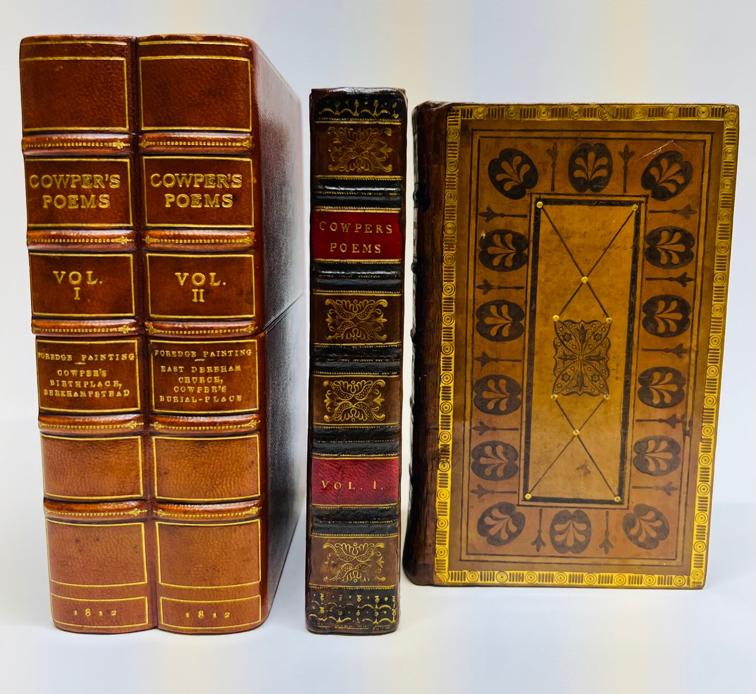

Booksellers of Antiquarian Books & Ephemera


SPECIALIZING IN CHILDRENS ILLUSTRATED BOOKS, FINE BINDINGS, FORE - EDGE PAINTINGS, SETS, CLASSIC LITERATURE, VOYAGES & TRAVELS.
E.C. Rare Books - Vancouver, BC. Canada - (1) 604.770.0911info@ecrarebooks.com - www.ecrarebooks.com
Catalogue of books with Fore-Edge Paintings
Fore-edge paintings followed the trends of the times. As the “picturesque” theme became popular, it was emulated in fore-edge paintings, turning away from symmetrical designs. Scrolls, floral designs, and biblical scenes were replaced by William Gilpin’s inspirations.
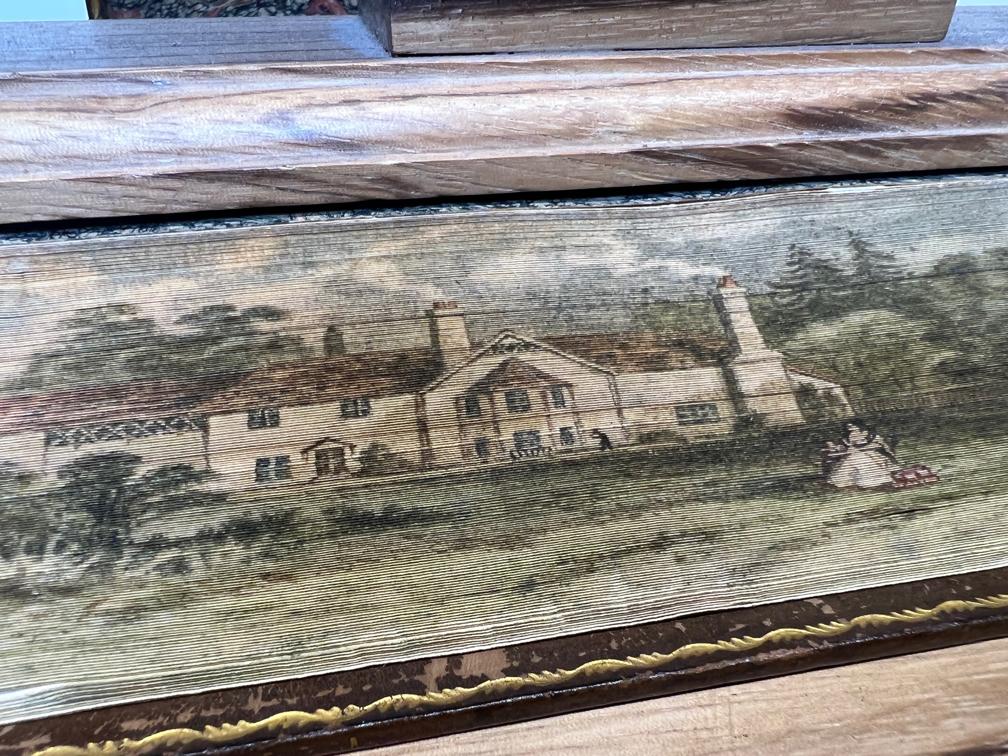
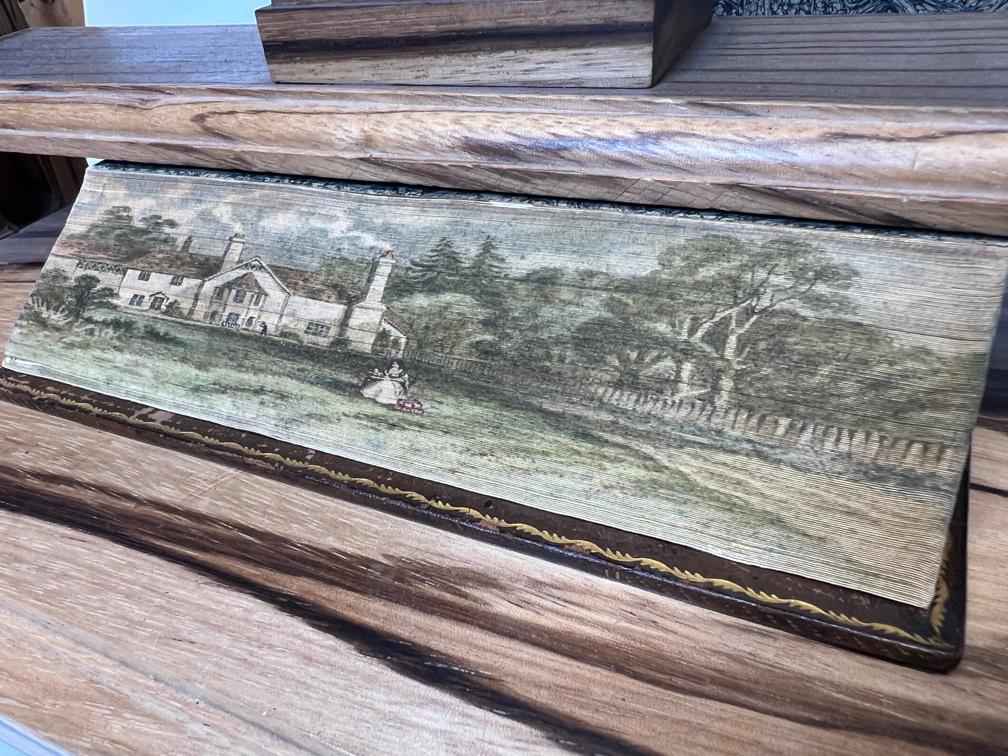
In general, the artists executing fore-edge paintings were copying other works. Painting popular works or imitating styles helped sell books. In fact, many books may have sold for the painting rather than the content. We also know that paintings were not always contemporary with the book; for example, Thomas Edwards may have added scenes to promote the sale of certain books after he had them in his shop for a few years.
Typically, very little is known about the painters. A painting may be signed or we may know that an artist worked for a particular binder but usually little beyond that. Books by English poets were the most popular to apply painting to,

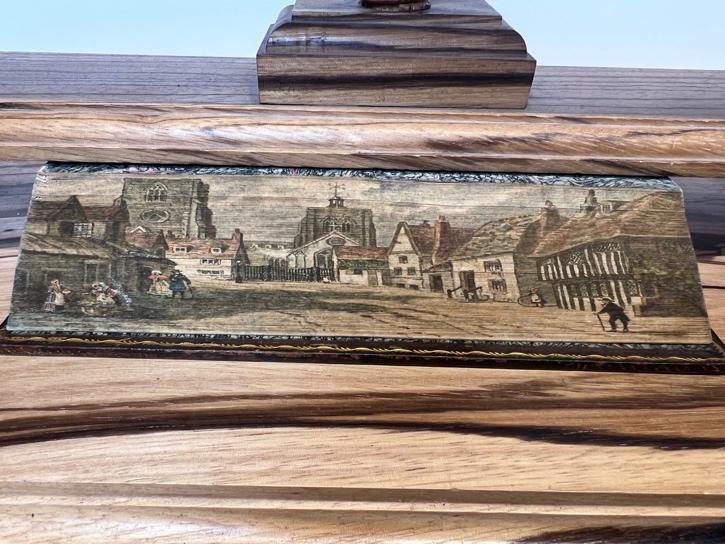

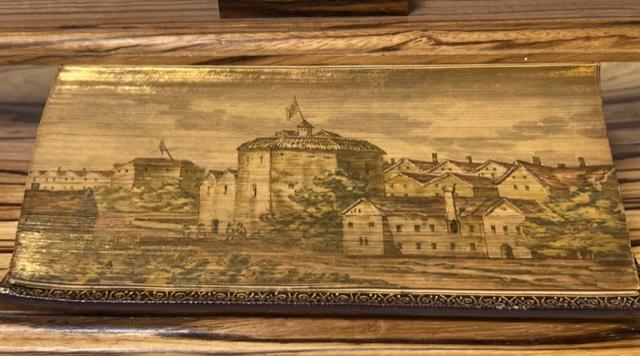
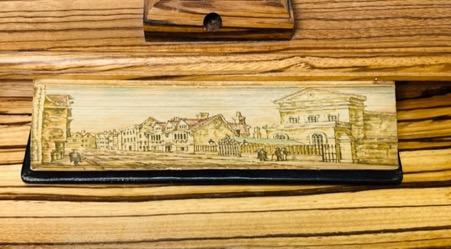


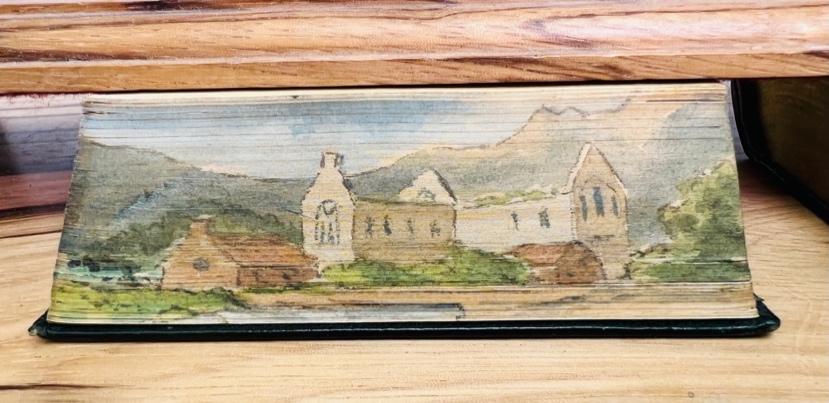
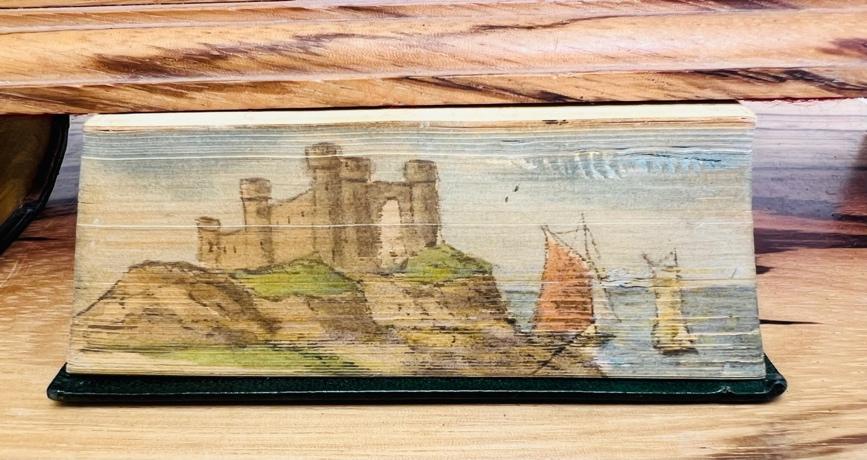
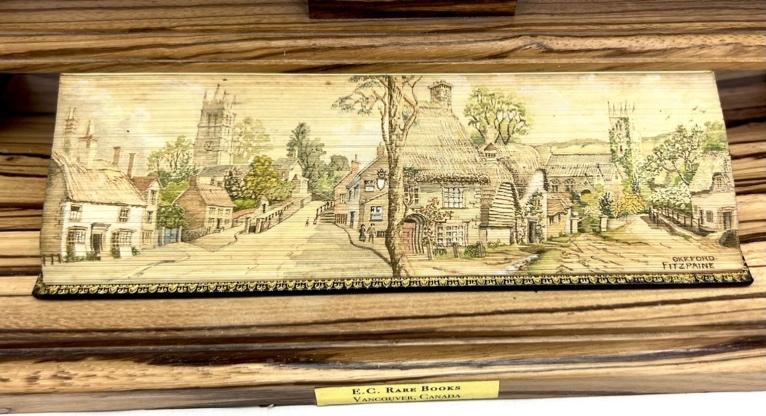
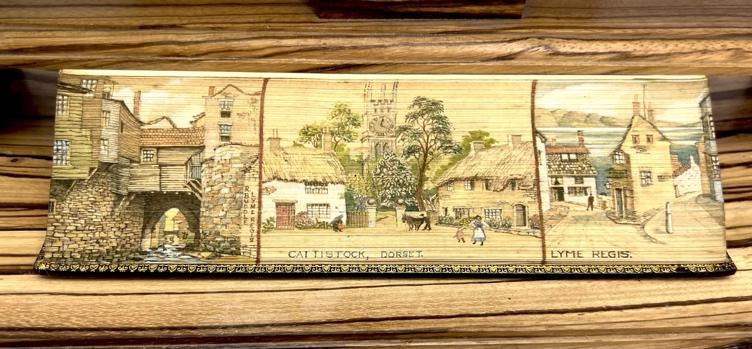
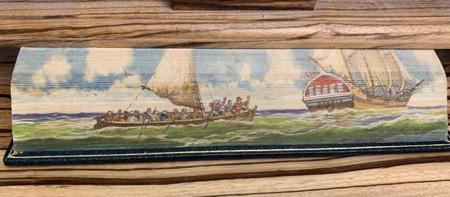
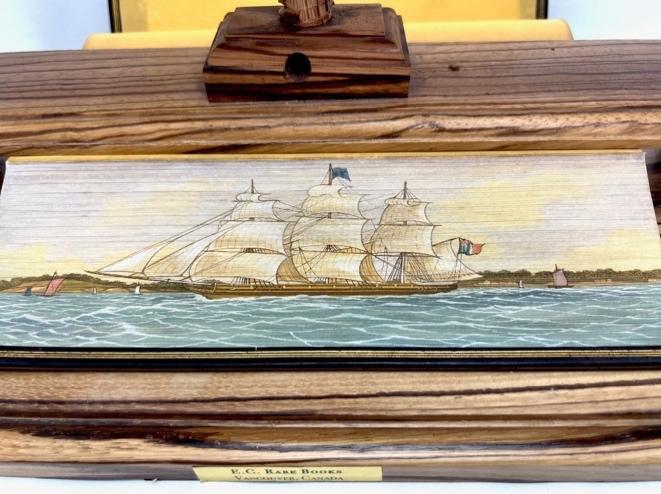
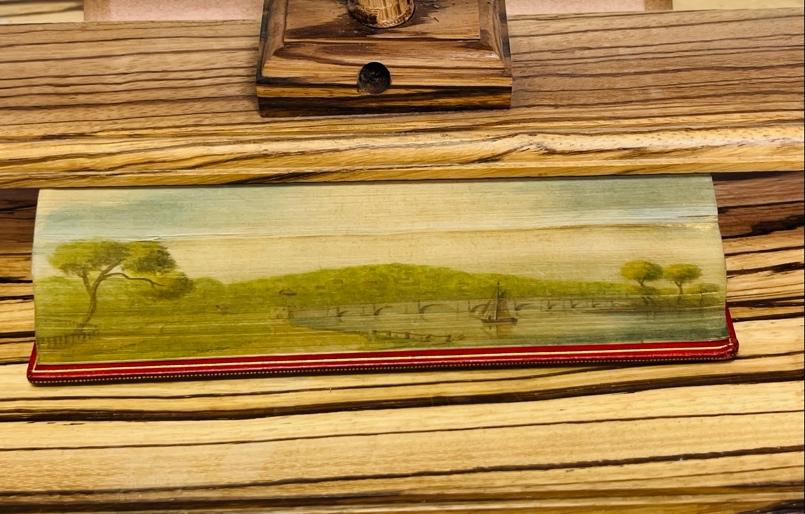



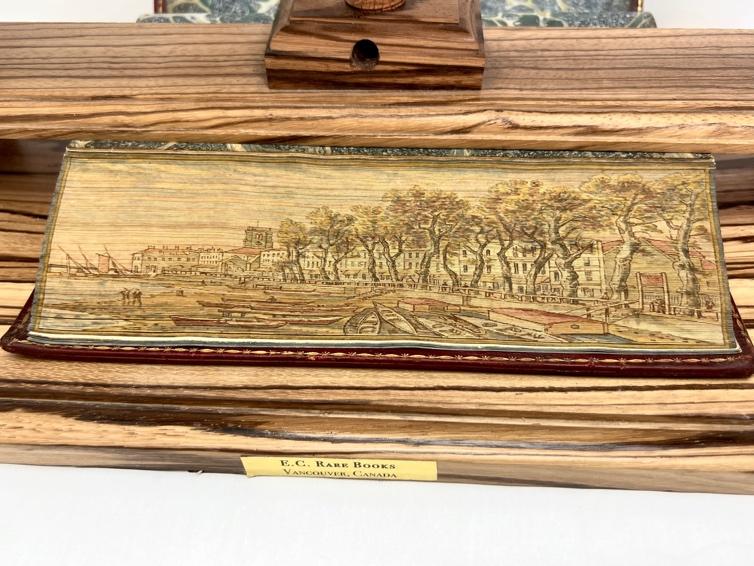

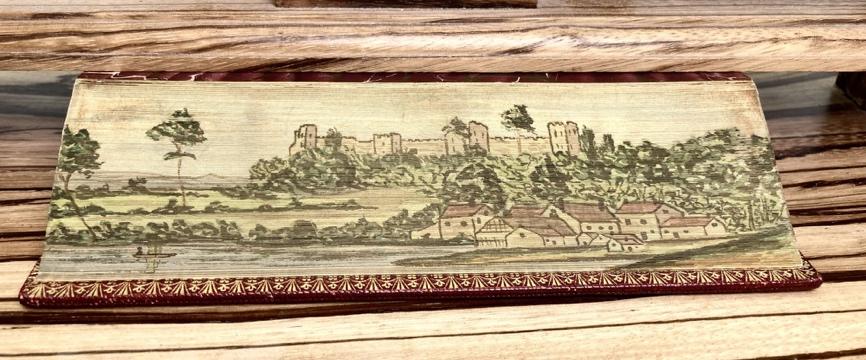


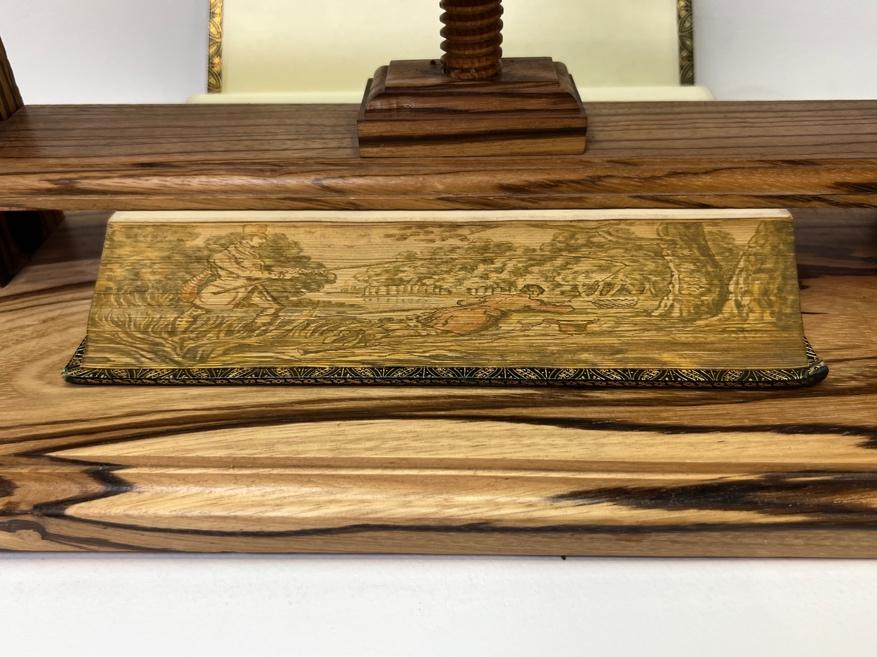
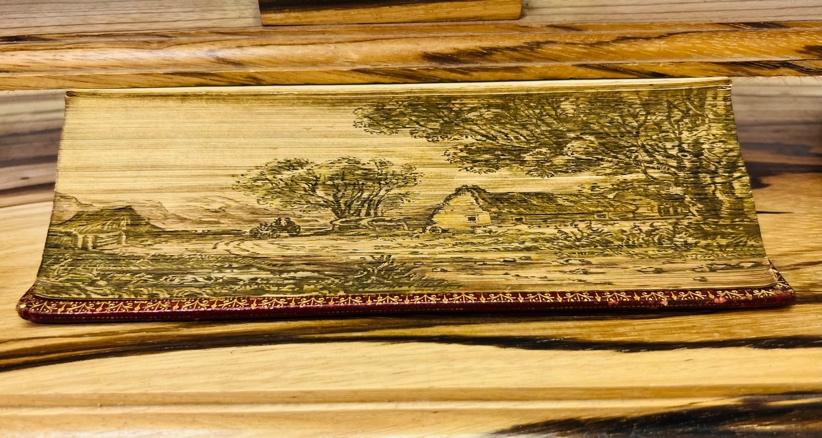

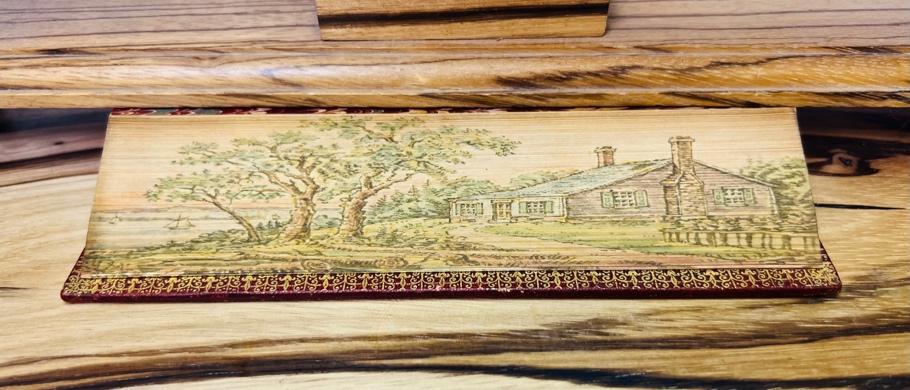
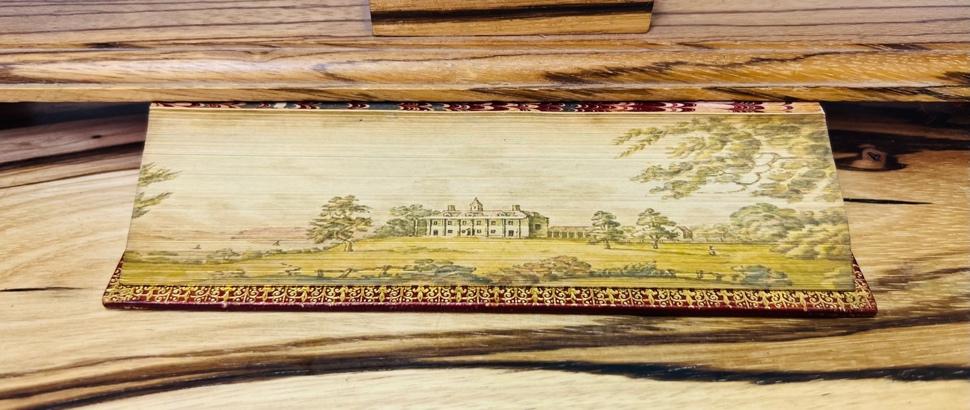

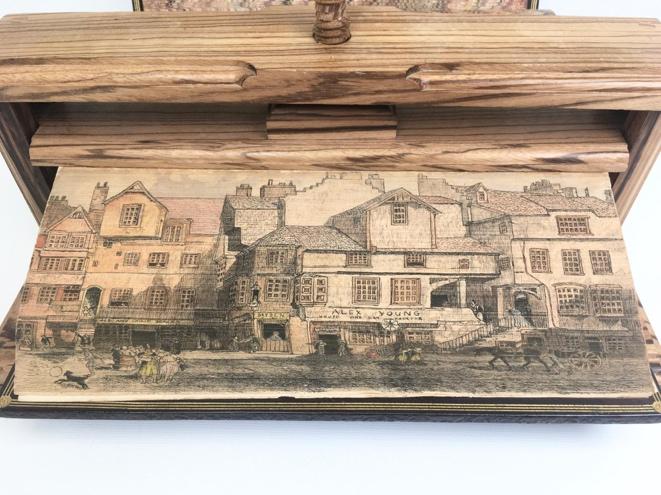
Item i. [FORE–EDGE PAINTING]

[EDWARDS OF HALIFAX] COWPER’S POEMS
COWPER, William (1731–1800).
London: T. Bensley for J. Johnson and Co., 1812
2 Volumes
Cowpers Poems, 1812. 2 volumes, 8vo (159 x 95 mm). ETRUSCAN CALF BY EDWARDS OF HALIFAX, covers with gilt pentaglyph and metope border, stenciled frame of palmettes, central panel enclosed by a stenciled border, enclosed is a stenciled device of a fan–like shape with tulips on a pointillé background and other geometric shapes, spine in 6 compartments with 5 raised bands, 2 red morocco lettering–pieces gilt, gilt–tooled in remainder, all edges gilt. Very Fine examples of Edwards of Halifax bindings with incredible Fore-Edge Painting relating to Cowper.
An interesting bit of bookbinding history, the tool maker Edwards used was a gentleman named John Paas from Holborn London. The center tool on the covers of these bindings was made by Paas. In 1832, on one of the many trips Paas was known for making around the UK showing his tools, designs and collecting monies for tools and engraved plates that had been purchased, he was traveling from up north, probably visiting Edwards. On passing down through Leicester, he stopped in at a binder called James Cook... Cook believed that Paas would be traveling home with a considerable amount of money and as Paas walked into Cook’s bindery, he was hit several times with an iron laying press pin. Paas only had
50 pounds on him. Cook spent the next three days trying to dispose of the body in his fireplace. Cook was captured and ended up historically being the last person in the UK to be Gibbeted.
CONTEMPORARY FORE–EDGE PAINTINGS
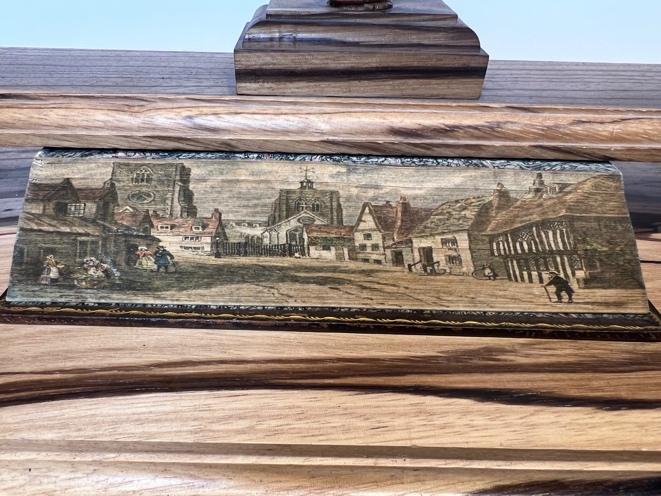
Depicting Berkhamsted (Cowper’s birthplaces) and East Dereham Churchyard (Cowper’s burial place).
Full Morocco vertical slipcase gilt stamped by Sangorski & Sutcliffe for Marshall Field & Co. (some rubbing along edges). Provenance: Presented by Gladys McKenney Molony to the Saint Mary–of–the–Woods College Library (inscription dated 11 November 1986 on verso of title–page), collector of fore–edge paintings.
[Edwards Of Halifax] The craftsmen behind design features that occupy a position of considerable importance in the history of bookbinding. The Edwards of Halifax bindery was founded by William Edwards (1723-1808) and continued by several of his brothers, halfbrothers, and sons (by far the most important of the sons being Thomas, who lived from 17621834). This famous firm produced a number of important innovations in binding design, the most significant being the idea of concealing a painting under the gilt of the fore edge. This hidden treasure could be revealed, once the edge was fanned out, as a special surprise element of the volumes they bound typically in Etruscan calf, as here, or in their patented transparent vellum. Although bindings produced by the Edwards workshop are never signed, the present item is such an absolutely characteristic example

of Edwards work that Weber cites it in a chapter devoted to distinguishing genuine Edwards bindings from the work of imitators. Especially telling here are the soft-hued colors in the paintings, a feature much less imitated than other aspects of Edwards volumes. While fore-edge paintings likely produced at the Edwards bindery (and especially produced by their imitators) appear in the marketplace with some regularity, most offered are octavo or duodecimo in size. Of the fore-edge paintings attributed to Edwards of Halifax that have appeared in RBH over the past 65 years.
Stunning Bindings and Fore-Edge Paintings rarely seen in this condition and not noted in Fore-Edge Painting reference works.
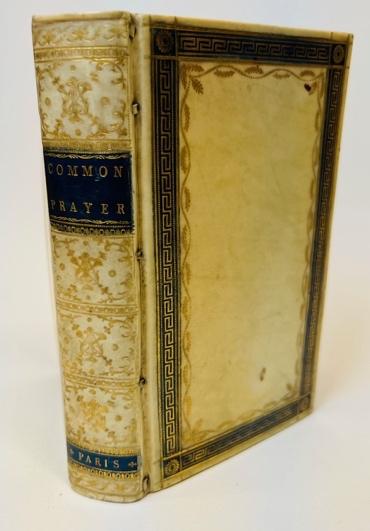
Price (USD) $8,600 | (GBP) 6,811.00
edge painting of St. Martin’s Church in Canterbury.
FORE-EDGE PAINTING

St. Martin’s Church in Canterbury,
Item ii [FORE–EDGE PAINTING] [EDWARDS OF HALIFAX]
THE BOOK OF COMMON PRAYER
P. Didot for W. Edwards and Sons, Halifax, 1791. Paris
A is particular imprint it states in Carl Weber’s “a Thousand and One Fore-Edge Paintings, page 139 [paragraph 8] 6 copies found in collections. These being particularly important as the books were printed, published, bound, fore-edge painted and sold by Edwards, showing their dedication to producing and selling amazing books and bindings as literary items and art work all in one. This would make an unrecorded copy to my knowledge not stated in the abovementioned reference work or in Jeff Webbers Annotated dictionary of Fore-Edge Paintings.
The Book of Common Prayer, Paris: P. Didot for W. Edwards and Sons, Halifax, 1791. 8vo (146 x 84 mm).
Provenance: Elizabeth Buckle (early signature dated 2 April 1810). Near Perfect Condition.
Price (USD) 7,800.00 | (GBP) 6,178.00
CONTEMPORARY VELLUM BY EDWARDS OF HALIFAX, covers with Greek key roll border on a blue wash background within gilt fillets, starburst corner pieces gilt, enclosing a leafy foliage gilt border, smooth spines gilt–lettered on a blue wash background and gilt–stamped with Greek harps and various small tools, marbled endpapers, all edges gilt, contemporary fore–
Item iii. [FORE-EDGE PAINTING]
THE WORKS OF WILLIAM SHAKESPEARE.
With Life, Glossary, Etc. Prepared from The Text of the First Folio, and The Quartos, Compared with Recent Commentators.

Shakespeare, William.
Published by London, Frederick Warne and Co., ca. 1890
FORE-EDGE PAINTING
The Globe Theatre
Albion Edition. Bound in Full brown Morocco, xvi, 1,136 p, engraved frontis portrait. with tissue guard, all edges gilt, marbled endpapers, five raised bands, black leather spine label with title in gilt, inner dentelles, gilt spine decorations, gilt rules on cover edges, printed in two columns, includes glossary (p. 1123-1136), The works of William Shakespeare: with life, glossary, prepared from the texts of the first folio. Gift inscription from A W J Talbot Eaton Christmas 1890 from his tutor.
approximately 750 feet (230 m) from the site of the original theatre.
Price (USD) $810.00 | (GBP) 651.00
Item iv. [FORE-EDGE PAINTING]
A HAND-BOOK FOR VISITORS TO OXFORD
Published by John Henry Parker, Oxford, 1847
FORE-EDGE PAINTING
Hollywell St and Holywell Music Room
FORE-EDGE PAINTING
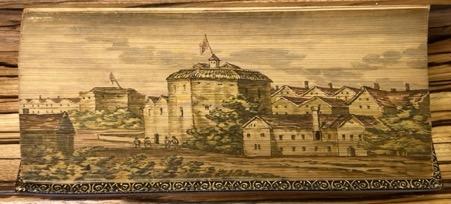
Globe Theatre
The Globe Theatre was a theatre in London associated with William Shakespeare. It was built in 1599 at Southwark, close to the south bank of the Thames, by Shakespeare's playing company, the Lord Chamberlain's Men. It was destroyed by fire on 29 June 1613. A second Globe Theatre was built on the same site by June 1614 and stayed open until the London theatre closures of 1642. As well as plays by Shakespeare, early works by Ben Jonson, Thomas Dekker and John Fletcher were first performed here. A modern reconstruction of the Globe, named "Shakespeare's Globe", opened in 1997
University and City of Oxford at rear, Bound in full Morocco, with gilt pictorial design of the Bodleian Library on the upper cover. Very Good Condition.
From the Introduction on the book…
The object of the present volume is to furnish the visitor with a hand-book for the University of Oxford, and to tell him in a few words the history, and chief points of interest, of those buildings which will meet his eye in his walks about it; but whilst dealing with the particulars, it must frequently occur to him, that he ought to be told something of the universal, something of the government or directing agencies by which the whole is so well harmonized, as he sees it, as also of those characteristics which distinguish the different members of the University whom he meets in the streets. We will endeavour therefore to supply him with a summary of the constitution of the University in the present Introduction.
FORE-EDGE PAINTING
Hollywell St and Holywell Music Room
The construction of the Holywell Music Room began in 1742 to the design of the Revd Dr Thomas Camplin (Vice-Principal of St Edmund Hall and Archdeacon of Taunton), at a cost of £1,263 10s. The Music Room opened in 1748, and is probably one of the earliest buildings in Europe erected especially for musical performances.
Price (USD) $580.00 | (GBP) 459.00
Item v. [FORE-EDGE PAINTING]
THE PRACTICE OF INTERIOR RECOLLECTION WITH GOD
Drawn from the Psalms of David By Father
Paul Segneri, S.J.London: M.H. Gill & son upper Sackville St, 1880.
Full Hard Grain Morocco.
The Practice of Interior Recollection with God. Drawn from the Psalms of David By Father Paul Segneri, S.J.
Dublin, M.H. Gill & son upper Sackville St 1880 12mo 148pp, a beautiful little volume in decoratively bound in full hard grain Morocco with white moiré end papers. Ink inscription on front free fly leaf “Souvenir of 1st Holy Communion …… Dec 8th 1904”

Very good condition.
FORE-EDGE PAINTING
A wonderful fore-edge painting of St. Pauls Cathedral London


Father Paul Segneri, S.J.
Italian Jesuit, preacher, missionary, ascetical writer, born in Nettuno, 21 March (cf. Massei) 1624; died in Rome, 9 Dec., 1694. He studied at the Roman College, and in 1637 entered the Society of Jesus, not without opposition from his father. The eloquent Oliva was his first master in the religious life; Sforza Pallacicini taught him theology. Under such guides his virtues and talents developed to maturity. He lectured on humanities for several years, and was ordained priest in 1653. By a careful study of Scripture, the Fathers, and the Orations of Cicero, he had prepared himself for the pulpit, for which he had ever felt a strong attraction.
He volunteered for the foreign missions, but Tuscany, the Papal States, and the chief cities of Italy were to be the scene of his labours. He preached at first in the great cathedrals, and then for twenty-seven years (1665-92) gave popular missions with an eloquence surpassed only by his holiness. His "Quaresimale" (Florence, 1679, tr. New York, 1874) had been read and admired by Antonio Pignatelli, who as Pope Innocent XII
summoned the missionary to preach before him, and made him theologian of the Penitentiaria. Segneri's biographer, Massei, states distinctly that "Le Prediche dette nei palazzo apostolico" (Rome, 1694) won the admiration of the pontiff and his Court. Very Good. Item #526
Price (USD): $620.00 | (GBP) 491.00
aristocratic, flamboyant and stylish as he was himself and as a consequence, he had no time for those men "Indian officers" who had learnt their profession over many years of service with the 11th during its long posting to India.
Item vi. [FORE-EDGE PAINTING]
THE LIVES OF OUR HEROES OF THE CRIMEA
Ryan, George
James Field and Co, London, 1855
This attitude was particularly in evidence in the mess: Cardigan had forbidden the serving of porter, a popular beverage among the professional officers, and when at a formal mess dinner, a visitor had requested Moselle wine, which was served in a "black bottle" similar to that of porter, he decided that the "Indian" Captain John Reynolds, who had ordered it for the guest, was defying him. Reynolds was arrested and in due course received a strongly worded reprimand from Lord Hill, who although privately believing that his misgivings about Cardigan had been well founded, felt that, in the interests of good order and discipline, a public demonstration of support was necessary.
FORE–EDGE PAINTING The Charge of the Light Brigade
This fore-edge painting is an inviting scene from the charge showing the soldiers, horses and cannons amidst the battlefield.

The Charge of the Light Brigade
Bound in full red hard grain Morocco extra gilt 408pp frontice piece very good condition Book plate on front paste down of William Waldergrave, another prominent family in the history of England. Very Good Condition.

George Ryan, a writer otherwise highly critical of Lord Cardigan, estimated that he spent about £10,000 (equivalent to £1,000,000 in 2021) a year towards remounts and distinctive uniform for his troops.[36] In purchasing brilliant new uniforms for his men, Cardigan caused resentment among his professional officers; they had to match the men's attire with even more costly uniforms (a Hussar officer's jacket, for example, cost £40 equivalent to £3,900 in 2021) and officers had to buy their own. He wished his officers to be as
Lord Cardigans’ most notorious exploit took place during the Crimean War on 25 October 1854 when, as a Major-General, in command of the Light Cavalry Brigade at the Battle of Balaclava, he led the Charge of the Light Brigade reaching the Russian guns before returning unscathed, in a manoeuvre that cost the lives of about 107 out of the 674 men under his command who took part in the charge (although others may have died of wounds later on). The extent to which Lord Cardigan was to blame is unproven since he attacked only after expressing his doubts and receiving a direct order in front of the troops from his immediate superior Lord Lucan, commander of the Cavalry Division. The two men were barely on speaking terms as Lucan was
married to one of Cardigan's sisters and, as Cardigan believed, did not treat her well. The order had been conveyed by Captain Louis Nolan, who died in the charge, and both Lucan and Cardigan blamed him for passing on the order incorrectly. Cardigan's first action on his return from the charge was to report the undisciplined behavior of Captain Nolan (whom he did not know to be dead) in riding ahead of him at the start of the attack.
Price (USD) $680.00 | (GBP) 538.00
Item vii. [FORE-EDGE PAINTING]
THE BOOK OF COMMON PRAYER, AND ADMINISTRATION OF THE SACRAMENTS.
[Bound with:] A New Version of The Psalms of David, Fitted to The Tunes Used in Churches. [With:] Proper Lessons to be read at Morning & Evening Prayer on the Sundays and other Holy-Days throughout the year. [The latter bound with:] The New Testament.
(Book of Common Prayer)
Printed at the University Press, Oxford, 1834
FORE-EDGE PAINTING
Vol I. Basingwerk Monastery.
Ranulf de Gernon was earl of Chester from 11291153. He offered Basingwerk to monks of the Norman abbey of Savigny, which enjoyed a briefly fashionable status in Norman Britain. The first monks from Savigny probably lived within the protective confines of a nearby Norman fortress known as Hen Blas.
The Savigniac order merged with the Cistercian order in 1147 and then a decade later the abbey was granted to Buildwas Abbey in Shropshire. In that same year, Henry II effectively re-founded the abbey, around the time the monks moved from Hen Blas to Basingwerk, at what is now called Greenfield.
Vol II. Conway Castle.
The site was occupied by a Cistercian monastery favoured by the Welsh princes, as well as the location of one of the palaces (called llys) of the Welsh princes. From Conwy: "the oldest structure is part of the town walls, now all incorporating the still standing Conway Castle.
Price (USD) $1,110.00 | (GBP) 879.00
2 vols., 48vo, ff. [287; 343]. Contemporary dark green paste grain morocco, boards bordered with a double-blind rule, spines divided by blind rules and lettered in gilt, all edges gilt, housed in the original black morocco vertical slipcase with tabbed lid. A plain but attractively bound pair of miniature devotional volumes.
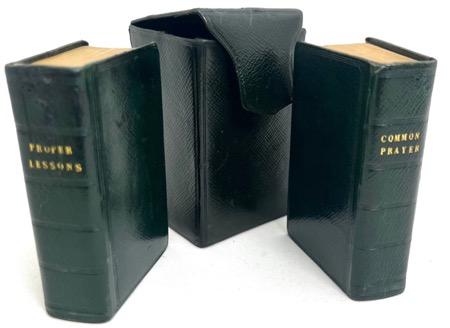
Item viii. [FORE-EDGE PAINTING]
THIRTY YEARS' CORRESPONDENCE
BETWEEN JOHN JEBB AND ALEXANDER KNOX
Edited by Charles Forster.
London: J. Duncan and J. Cochran, 1834.
2 Vols each with a fore-edge painting. Bound in full Maroon straight grain Morocco, bound by J. Hatchard’s and son Piccadilly. A beautiful combination of blind and gilt tooling in excellent condition.
FORE-EDGE PAINTINGS
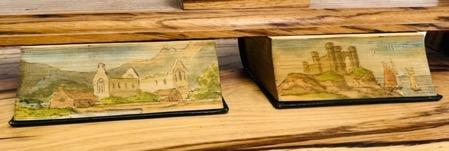
Scenes of Dorset – Lyme Regis – Ockford –Cattistock
This incredibly detailed Fore-edge painting on Vol I is a church and street view of Okeford fitzpaine In 1086, the Domesday Book recorded
Okeford Fitzpaine as Adford; it had 40 households, 16 ploughlands, 21 acres (8.5 hectares) of meadow and one mill. It was in Sturminster Newton Hundred and the tenant-inchief was Glastonbury Abbey. Since then, it has been known as "Aukford Alured" and "Ockford Phippin", the latter echoing the modern colloquial "Fippenny Ockford" and its shorthand, "Ockford".
owned part of the town. Lyme is mentioned in the Domesday Book of 1086. In the 13th century, it developed as one of the major British ports. A Royal Charter was granted by King Edward I in 1284 when "Regis" was added to the town's name. The charter was confirmed by Queen Elizabeth I in 1591.
Vol. II is even more detailed and split into three individual scenes.
Buddle Bridge, Lyme Regis. Believed to be the third oldest bridge in Dorset, Buddle Bridge is a delightful Grade I listed bridge hidden under the main road through Lyme Regis. Of both historical and archaeological significance, this medieval gem is best viewed looking back from Gun Cliff Walk or from the beach below at low tide. According to The Lyme Regis Society, the bridge has one arch, circa 1200-1240, which survives in a Street over the river Lim, has been adapted many times although some of the original fourteenth century medieval masonry such as the four equally spaced, pointed segmental, ashlar ribs still form part of the structure.
John Leland visited in the 16th century and described Lyme as "a praty market town set in the rootes of a high rokky hille down to the hard shore. There cummith a shalow broke from the hilles about three miles by north, and cummith fleting on great stones through a stone bridge in the bottom."
Very fine detailed fore-edge paintings.
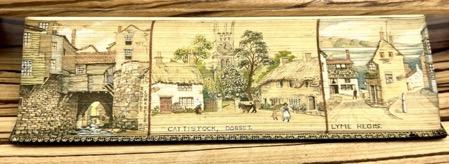
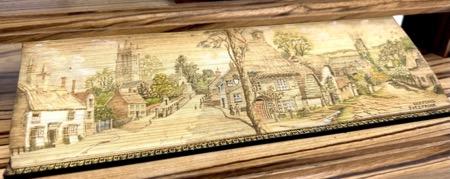
Cattistock Dorset. Cattistock is a village and civil parish in west Dorset, England, sited in the upper reaches of the Frome Valley, eight miles (13 km) northwest of the county town Dorchester. The Dorset poet William Barnes called it "elbowstreeted Cattstock", a comment on the less-thanlinear village street.
Lyme Regis Dorset. In Saxon times, the abbots of Sherborne Abbey had salt-boiling rights on land adjacent to the River Lym, and the abbey once
Thirty Years' Correspondence between Bishop Jebb and Alexander Knox,’ edited by the Rev. C. L. Forster, Bishop Jebb's biographer. These letters show his close agreement in many points with the leaders of the Oxford movement, then beginning. In an article in the ‘Contemporary Review,’ August 1887, Professor Stokes traced the movement of thought from Wesley to Knox, from Knox to Jebb, and from Jebb to Hugh James Rose, Newman, and Pusey. The theory was impugned by Dr. Church, dean of St. Paul's, and defended by Professor Stokes in the Guardian (7, 14, 21, and 28 Sept. 1887); but both agree that Knox anticipated much of what was afterwards insisted upon by the leaders of the revival. Keble, while admiring Knox, thought him an eclectic, looking down upon all schools with an air of superiority (Coleridge, Memoir, p. 241).
Knox contends that ‘the church of England is neither Calvinian nor Augustinian, but eminently and strictly catholic, and catholic

only;’ that ‘our vitality as a church is in our identity of organisation with the church catholic;’ that the church of England is not protestant, but a reformed branch of the church catholic; that the English church is the only representative of the spirit of the Greek fathers, and that we ought to aim at union with the Greek church.” He disliked Calvinism in every form; and he argued that our justification is an imparted, not an imputed, righteousness. This last view was especially obnoxious to the evangelicals, and was opposed, among others, by G. S. Faber [q. v.] in ‘The Primitive Doctrine of Justification Investigated’ (1837). Knox lamented the general deadness of the services as conducted in his day; he rebelled against the identification of churchmanship with toryism, and he took both the primitive and the seventeenth century churches as his models. Like Wesley, he admired mystical writers like à Kempis, De Sales, and De Renty. He had no tendency to Rome, although he was a steady advocate of Catholic emancipation and a supporter of Maynooth. He exercised a great influence through his friend Bishop Jebb. The appendix to Jebb's sermons in 1815 (not quite accurately described as the first publication that recalled men's attention to Anglo-catholic principles) was avowedly the joint production of Knox and Jebb, and it is plain that Knox was truly the inspirer of the thought expounded by Jebb. Price (USD) $2,675.00 | (GBP) 2,118.00
First Edition of the first work in the Bounty Trilogy, based on the 1787 mutiny in Tahiti. Throughout history, few voyages are as infamous as that of the bounty. Even before the doomed sailing, the naval exploits of Lieutenant William Bligh and his participation in the third and final voyage of Captain James Cook, were quickly becoming legend. Sailing with such a distinguished officer should have been an honour but this was not the case.
On April 28th, 1789, the HMS Bounty was taken over by disgruntled crew members, led by acting Lieutenant Fletcher Christian.
Nordhoff, Charles
Boston: Little, Brown & Co., 1932. First Edition.
FORE-EDGE PAINTING
Nordhoff, Charles (1878-1947). Hall, James Norman (1887-1951).
20th-century blue crushed levant gilt, upper cover with central illustration of a ship in white, red and green morocco on-lay, edges gilt, concealing a Fore-Edge Painting of the H.M.S. Bounty and a ship of mutineers at sea; quarter morocco gilt slipcase.

The mutiny came on the heels of a lay-over in Tahiti, which lasted for months. During this time, crew members began to form relationships with locals and acclimatize to the environment. In an effort to maintain authority, Bligh began to hand out harsher punishments, which were not well received.
Tales of rebellion have always captivated audiences but it is the series of events that followed the mutiny that make Bligh's story so interesting. Following their discharge from the Bounty, Bligh and his loyalists were set adrift in a launch with a set amount of provisions. Despite making attempts to find temporary settlement on the island of Tofua, the crew was met with hostility and forced to flee. Following this nearfatal encounter, Bligh and his crew embarked on a voyage to the Dutch settlement of Timor, some 3,500 nautical miles away. This mission would allow Blight to properly chart the coastline but it would also mean drastically reducing rations among crew, which was unanimously accepted.
Item ix. [FORE-EDGE PAINTING] MUTINY ON THE BOUNTYAfter a successful landing at Timor, Blight was able to return to England. Following an acquittal for the events that led to the mutiny, Bligh was appointed the title of Post-Captain and in November 1790, the HMS Pandora was launched, directed to apprehend the remaining crew members who had committed the mutiny. After capturing the remaining 14 mutineers, the Pandora ran aground on the Great Barrier Reef, sinking shortly afterward. The story of the Bounty has been retold in many editions and has gone on to inspire books, articles and films in the centuries since these events took place.
Charles Nordhoff (1887-1947) was an Englishborn, American novelist. Nordhoff wrote his first book The Fledgling in 1919, following his military service. After its publication, the author was commissioned by Harper's Magazine to create travel articles. After travelling to Tahiti, Nordhoff met and married a local woman and was inspired to create the Bounty Trilogy, for which Mutiny on the Bounty is the first instalment. Very Good.
Item #358
Price (USD): $3,850.00 | (GBP) 3050.00
An Exposition of the Creed 616 pages, was a work by John Pearson which was first published in 1659. It was based on sermons he delivered at St Clement's, Eastcheap. It was one of the most influential works on the Apostles' Creed in the Anglican Church. Bound in full maroon straight grain Morocco, extra gilt on the covers, and spine with a Portcullis emblem on the spine and rear board, book plate of Edward Thomas King on the rear pastedown (upside down). A wonderful
Item x. [FORE-EDGE
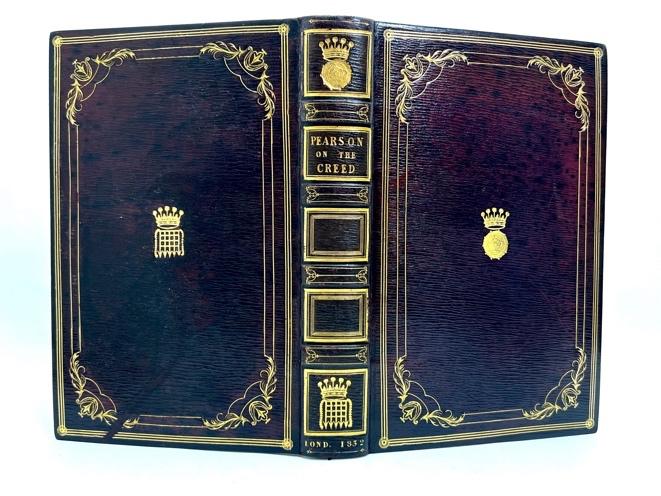

PAINTING]
AN EXPOSITION OF THE CREED

A new edition. Edited by the Rev. C. Bradley
... With a biographical sketch of the author, and a list of his works
John PEARSON (Bishop of Chester.)
Printed and Sold by J. F. Dove, 1832
copy with clean text. Excellent Condition
The Apostles' Creed (Latin: Symbolum Apostolorum or Symbolum Apostolicum), sometimes titled the Apostolic Creed or the Symbol of the Apostles, is a Christian creed or "symbol of faith". The creed most likely originated in 5thcentury Gaul as a development of the Old Roman Symbol, the old Latin creed of the 4th century. It has been in liturgical use in the Latin rite since the 8th century and, by extension, in the various modern branches of
Western Christianity, including the modern liturgy and catechesis of the Catholic Church, Lutheranism, Anglicanism, Presbyterianism, Moravianism, Methodism, and Congregational churches.
FORE-EDGE PAINTING

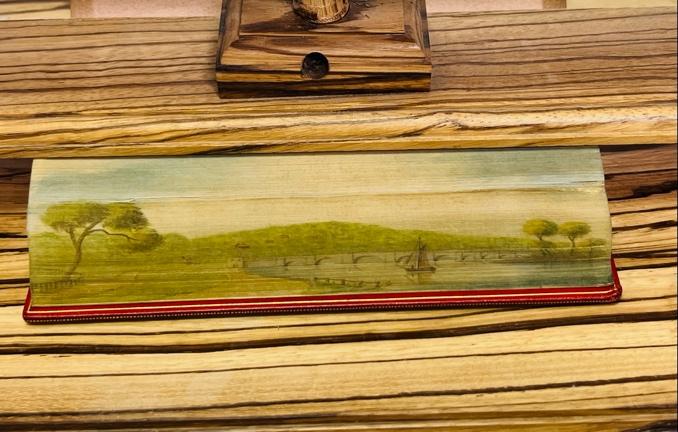
of the Whaling Ship Samuel Enderby
Samuel Enderby (17 January 1719 – 19 September 1797) was an English whale oil merchant, significant in the history of whaling in the United Kingdom. In the 18th century, he founded Samuel Enderby & Sons, a prominent shipping,
Enderby & Sons whaling company in further detail.
Price (USD) $1,275.00 | (GBP) 1,009.00
Item xi. [FORE-EDGE PAINTING] THE FORSYTE SAGA
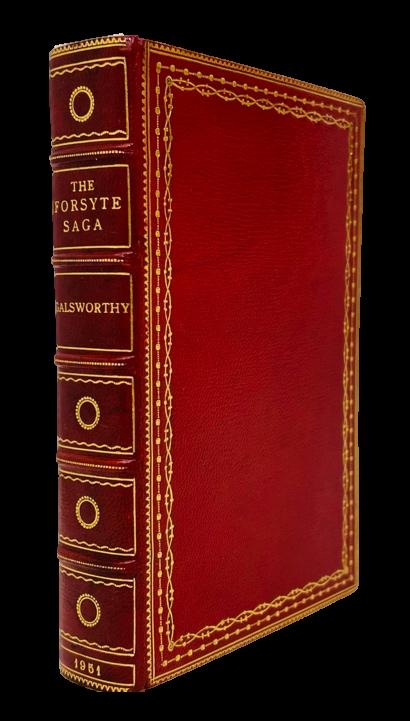
John Galsworthy
William Heinemann Ltd / Windmill Press 1951
whaling, and sealing company.
The Enderby family had been tanners (leather workers) at Bermondsey, and supported Oliver Cromwell. Daniel Enderby, I raised money for the army in the Long Parliament, as recorded in Hansard. The family was granted forfeited estates at Lismore, County Waterford, Ireland, which were sold in 1660. After that time, the family was active in the 'oil and Russia trade' and traded with the New England colonies.
On 2 June 1752, Samuel Enderby II married Mary Buxton, a daughter of his business partner, at St Paul's Wharf in London. Enderby died in 1797, leaving the company to his three sons Charles, Samuel III, and George. Samuel Enderby III (1755-1829) owned Britannia; the ship that made the first successful whale catch off Australia (10 November 1791). He was the grandfather of Major-General Charles George Gordon.
Fictional references
In Chapter 100 of the novel Moby-Dick, the Pequod of Nantucket meets a whaling ship of London named the Samuel Enderby, which has also encountered the White Whale. The Samuel Enderby was a real ship, which was in fact among the three Enderby company ships (the other two were the Fancy and the Brisk) from England that arrived at Port Ross in 1849 carrying the 150 colonists for the new Enderby Settlement. Chapter 101 of Moby Dick discusses Samuel
This is the 1951 reprint from 1922 including folding family tree chart as frontice 1042pp not illustrated as per the original 1922 edition. Bound in full red straight grain Morocco for Henry Sotherans, Ltd. With tipped in signature of John Galsworthy dated March 11 1916. The Forsyte Saga was first published in its entirety in 1922; the illustrated single volume edition with Anthony Gross's highly acclaimed drawings was first published in 1950. The Forsyte Saga earned Galsworthy the Nobel Prize for Literature in 1932, and his tales of the vicissitudes of a large upper-middle-class English family have been adapted under various guises for film and television, including the 1949 Hollywood film That Forsyte Woman, starring Errol Flynn, Greer Garson, Walter Pidgeon, and Robert Young.
View of Richmond Bridge, London. Beautifully painted showing the bridge and its quaint surroundings. Two of these books were commissioned by Southrens to be bound by Reiviers, both with Fore-Edge Paintings, the other in Blue Straight Grain Morocco.
Price (USD): $1,200.00 | (GBP) 950.00
In 1813, Byron encouraged Moore to compose an "oriental poem," but when Lalla Rookh finally appeared in 1817 it also seemed belated and imitative, anticipated by Byron's incredibly popular series of Eastern tales, written at breakneck speed. In fact, Moore had to abandon one of the narratives that he had been writing for

FORE-EDGE PAINTING AVAILABLE BUT NOT SHOWN AT FIRSTS LONDON
Item xii. [FORE-EDGE PAINTING] LALLA ROOKH AN ORIENTAL ROMANCE
Thomas Moore
Longman, Brown, Green, Longmans and Roberts, London, 1858
Lalla Rookh because it resembled Byron's The Bride of Abydos (1813) too closely. During his association with Byron, Moore's confidence in himself eroded; Vail notes that "Moore's letters and journals show that he consistently ranked Byron's poetry far more highly than he did his own, believing that the popularity of his own works would probably not outlive him" (137). In 1822, both Moore and Byron were inspired to write works based on the legend of angels falling in love with antediluvian mortal women, but in this case, Moore was careful to stay out of his friend's shadow by making sure his The Loves of the Angels was published before the appearance of Byron's Heaven and Earth in Leigh Hunt's the Liberal.
This illustrated edition of Moore’s famous romance. Bound in Full red hard grain Morocco, full gilt spine and gilt decorative panels on the front and rear boards, yellow surface paper ends. A very nice clean copy inside and out.
Lalla Rookh comprises of four narrative poems, with a connecting tale in prose. The heroine of the tale is Lalla Rookh which means 'tulip cheeked' and is used as an endearment in Persian poetry. Written by Irish poet, singer, songwriter and entertainer, Thomas Moore.
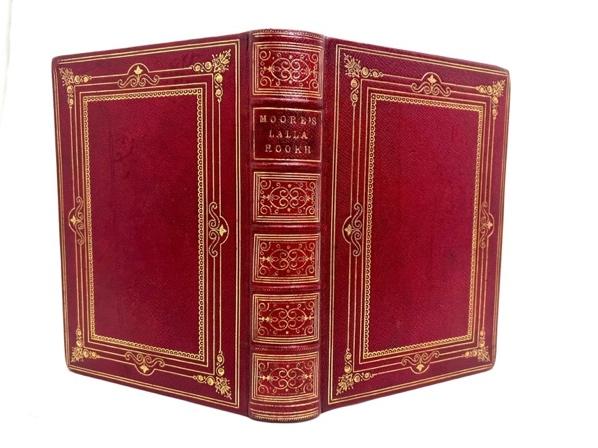
FORE-EDGE PAINTING
Tower of London from Tower Hill
A wonderful early Fore-edge Painting of Victorian London’s Tower of London from Tower Hill
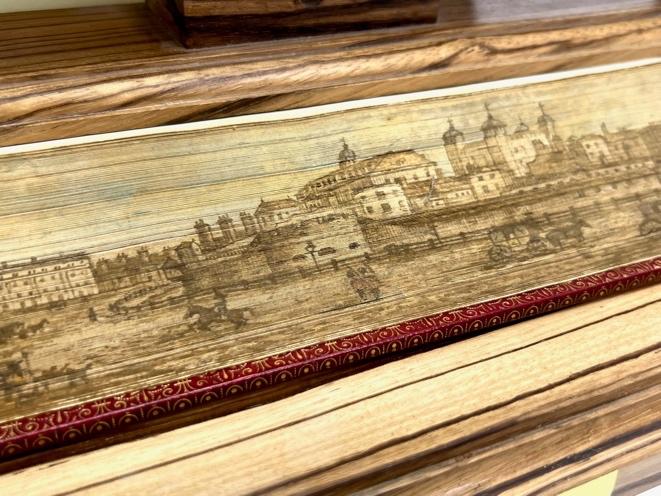
Tower Hill is infamous for the public execution of high-status prisoners from the late 14th to the mid 18th century. The execution site on the higher ground north-west of the Tower of London moat is now occupied by Trinity Square Gardens. Tower Hill also covers a wider area surrounding the Tower of London in the London Borough of Tower Hamlets, rising from the north bank of the River Thames
Price (USD): $1,750.00 | (GBP) 1,386.00
Bound in full forest green hard grain Morocco, gilt paneling on the front and rear boards, full gilt spine, marble endpapers and gilt dentles. A beautiful tight binding and very crisp clean text. Near perfect condition.
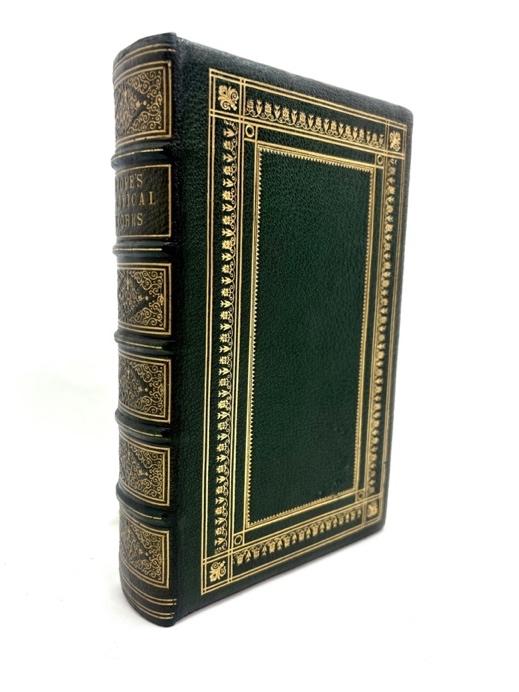
Item xiii. [FORE-EDGE PAINTING]
THE POETICAL WORKS OF ALEXANDER
POPE
With Memoir, Critical Dissertation, and Explanatory Notes, by George Gilfillan. The Gilfillan Poets, series
POPE, Alexander
Edinburgh, London, Dublin. James Nichol & James Nisbet and Co. 1856.
2 Vols in one. Alexander Pope (1688-1744), English poet, literary dictator of his age and regarded as the English epitome of neo-Classicism. His poetry is characterized by satire, epigram, didacticism, smoothness and technical finish, invective, biting and malicious wit, and skillful use of the closed or heroic couplet. Pope, a Catholic and the son of a linendraper in London, was unable to attend a public school or a university because of governmental restrictions against Catholic after the Revolution of 1688. A hunchback and cripple as the result of a serious illness in childhood, Pope relieved his sense of rancor in jealous, spiteful, and venomous attacks on his contemporaries; because of this, he was called the "Wicked Wasp of Twickenham", form the name of the London suburb where he lived. He was a Tory in politics and a friend of John Gay and Jonathan Swift. His best-known works are "Pastorals", 1709; "Essay on Criticism", 1711; which made Pope famous and which, he claimed he wrote when he was only twelve years old; "The Rape of the Lock", 1712; "Windsor Forest", 1713; translations of the "Iliad", 17151720; and the "Odyssey", 1725 -1726
FORE-EDGE PAINTING
An early fore edge painting of Windsor great park and Castle.
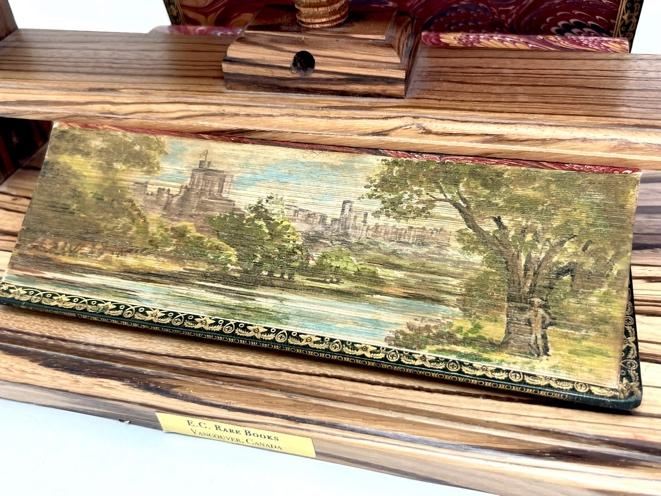
Windsor
“Thy forests, Windsor! And thy green retreats, at once the Monarch’s and Muse’s seats, Invite my lays.”
Price (USD): $1,350.00 | (GBP) 1,069.00
Item xiv
[FORE-EDGE PAINTING]
MILTON'S PARADISE REGAINED with Select Notes Subjoined: to which is added a Complete Collection of his Miscellaneous Poems, both English and Latin
Milton, John
Printed by Bensley for Printed by T. Bensley; for T. Longman, B. Law, J. Johnson, C. Dilly, G.G. and J. Robinson, W. Richardson, W. Otridge and Son, R. Baldwin, F. and C. Rivington, J. Scatcherd, Ogilvy and Speare, W. Lowndes, G. and T. Wilkie, G. Kearsley, Vernor and Hood, T. Cadell, Junior, and W. Davies, and S. Hayes. London, 1796
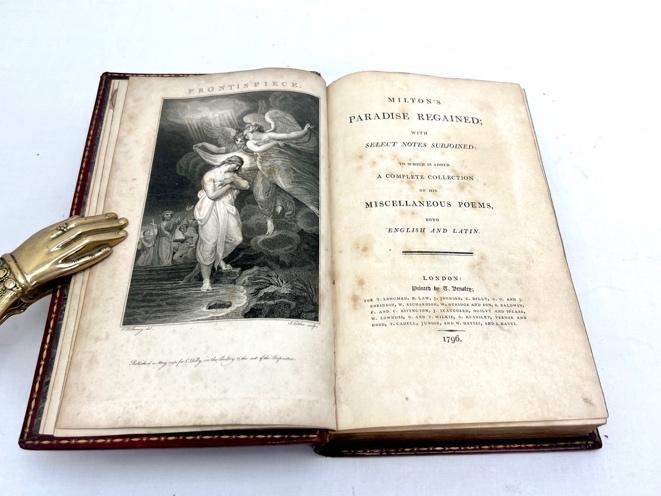
Bound in 18c full red straight grain Morocco simple gilt lines on the board and spine stormont pattern marble endpapers. Slight wear to the head and board edges, commensurate with its age. Engraved frontice and three engraved plates throughout, some foxing of the plates and prelims. 428pp. bookplate on front paste down. R.Foyle booksellers ticket to the inside of the front fly leaf. Paradise Regained, this collection includes Samson Agonistes, poems upon several occasions, sonnets, psalms, a Latin ode to John Milton by Joannes Baptista Mansus (Poemata), & select notes on Paradise Regained.
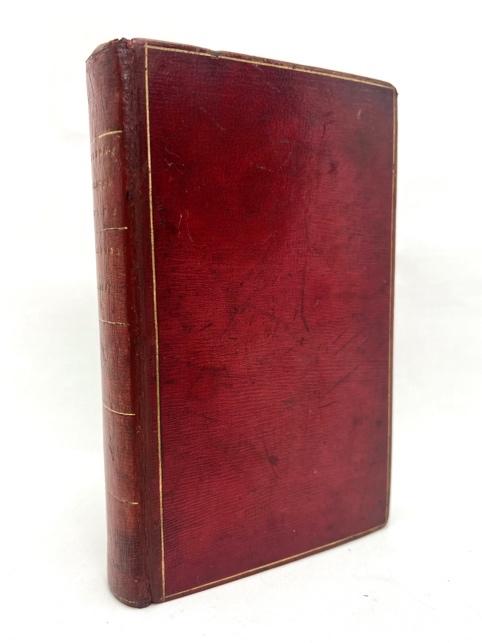
FORE-EDGE
PAINTING
A very early fore-edge painting, unsigned and un-named, probably an English estuary lined with houses and park and a dock leading to small river boats for possible rental and a church clock tower in the back ground. A wonderfully detailed painting.
Milton’s works became one of the earliest works for fore edge painting to be executed on with some eriod as early as 1779.
Price (USD): $2,750.00 | (GBP) 2,178.00
people, of whom two were convicted and sentenced.
Item
xv. [FORE-EDGE PAINTING]
JUNIUS. STAT NOMINIS UMBRA. A NEW EDITION. (LETTERS OF JUNIUS)
Junius
London: Printed for Vernor, Hood, and Sharpe, J. Walker, J. Cuthell, Longman, Hurst, Rees, and Orme, J. and J. Richardson; Lackington, Allen and Co.; Otridge and Son; J. Faulder; J. Murray; W. Stewart; and R. Scholey, 1810
Junius himself was aware of the advantages of concealment, as he wrote in a letter to John Wilkes dated September 18, 1771. Two generations after the appearance of the letters, speculation as to the authorship of Junius was rife. Sir Philip Francis (1740 - 1880), an Irish-born British politician and pamphleteer, is now generally, but not universally, believed to be the author.
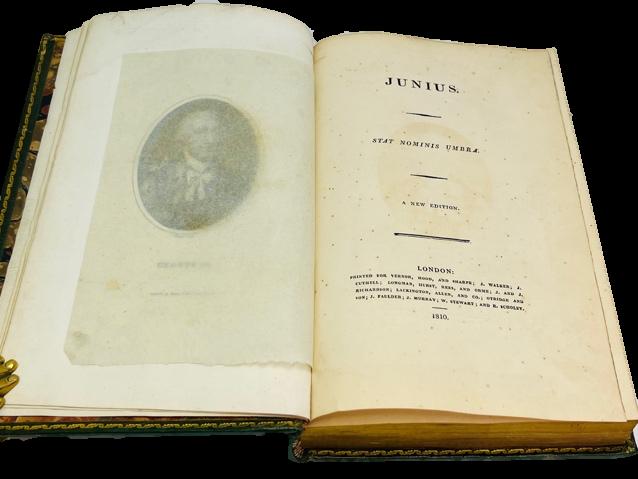
FORE-EDGE PAINTING Yarmouth Isle of White


The Foredge is of outstanding intricacy, a detailed painting of Yarmouth showing sail boats and the port in the background, and a small tri mast sailboat in the foreground under full sail and crew battling the strong off shore winds of the Isle of white.
Full Green straight-grained morocco marbled end papers. Gilt Spine, Engraved frontispiece portrait of George III. All edges gilt. Collated: xxxi, iii, 380 pages, 12 engraved portraits.
Junius was the pseudonym of a writer of a series of political letters to London's, Public Advertiser, from 1769 to 1772 as well as several other London newspapers, such as the London Evening Post. The Letters of Junius had a definite objective: to inform the public of their historical and constitutional rights and liberties as Englishmen; and to highlight where and how the government had infringed upon these rights. Because of the letters, charges were brought against several
Yarmouth is a town, port and civil parish in the west of the Isle of Wight, off the south coast of England. The town is named for its location at the mouth of the small Western Yar river. The first account of the settlement is in Æthelred the Unready's record of the Danegeld tax of 991, when it was called Eremue, meaning "muddy estuary". The Normans laid out the streets on a grid system, a plan which can still be seen today. It grew rapidly, being given its first charter as a town in 1135. The town became a parliamentary borough in the Middle Ages, and the Yarmouth constituency was represented by two members of Parliament until 1832 until the castle was built, raids by the French hurt the town; in 1544 it was reputed to have been burned down.
Price (USD): $1,150.00 | (GBP) 910.00
Item xvi. [FORE–EDGE PAINTING].
MEMOIRS OF EMINENT ETONIANS
Creasy, Edward
London: Chatto and Windus, 1876. New Edition.
Full Hard Grain Morocco. CREASY, Edward, sir (1812–1878). Memoirs of Eminent Etonians, with an inscription by an Eton scholar and great nephew to Jane Austen.
Edward Austen–Leigh (nephew to Jane Austen and biographer of “A Memoir of Jane Austen”) and graduate at the top of his class of both Eton and King’s College, later becoming an Assistant Master in 1861 of his first alma mater, and a permanent member of the Eton staff during the following summer. In 1887, Austen–Leigh became Lower Master of Eton cementing his legacy in the 1901 Vanity Fair’s “Men of the Day” (No. 811) titled “The Flea”. Very good. Item #318
Very good with wonderful Fore-Edge of a Dog retrieving a Duck on a country shoot

Association Copy Austen.
Price (USD): $2,150.00 | (GBP) 1,702.00
London: Chatto and Windus, 1876. 8vo. Illustrated with full plates including frontispiece. Presentation binding in full umber grain morocco, raised gilt titling in compartments, dentelle turn pale yellow endpapers, all edges gilt. Originally published in 1850 this new edition has frontice and 12 portrait illustrations throughout.
FORE–EDGE PAINTING
A hunting scene Black Labrador retrieving a duck, Inscribed by a Scholar of Eton and Lower Master of the University on front flyleaf: “Charles Fitzpatrick Burroughs/from/Edward Austen

Item xvii. [FORE-EDGE PAINTING]
THE POETICAL WORKS OF GEORGE HERBERT

Rev A. B. Grosart LLD
London: George Bell and Sons, 1892. Revised Edition.
Full Red Morocco. Herbert, George. The Poetical Works. Frontispiece. 8vo, contemporary full red morocco gilt-stamped Sherborn School prize binding by Bickers & Son, spine lettered in gilt in compartments, all edges gilt, spine tips and raised bands rubbed, abraded school prize bookplate to front pastedown. Revised edition. Fore-edge painting with view of Ludlow Castle, Shropshire. London, 1892
Herbert, George. The Poetical Works. Frontispiece. 8vo, contemporary full red morocco giltstamped Sherborn School prize binding by Bickers & Son, spine lettered in gilt in compartments, all edges gilt, spine tips and raised bands rubbed, abraded school
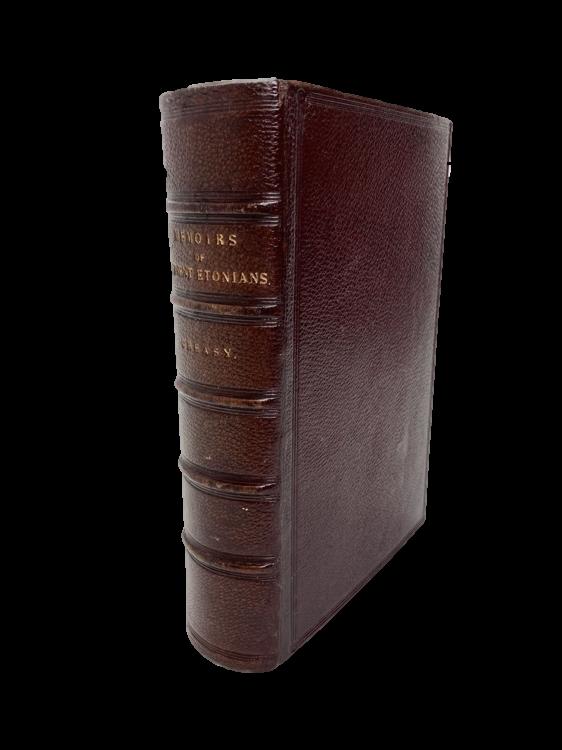
prize bookplate to front pastedown. Revised edition.
FORE-EDGE PAINTING
Fore-edge painting with view of Ludlow Castle, Shropshire. The architecture of Ludlow reflects its long history, retaining a blend of several styles of building. The castle is approximately 500 by 435 feet (152 by 133 m) in size, covering almost 5 acres (2.0 ha). The outer bailey includes the Castle House building, now used by the Powis Estate as offices and accommodation,
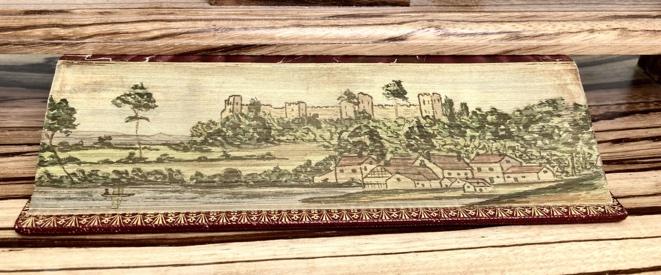
Item xviii [FORE-EDGE] MANT RICHARD THE BOOK OF COMMON PRAYER;
The Book of Common Prayer According to the use of the United Church of England And Ireland: Together with The Psalter or Psalms of David; And the Thirty-Nine Articles of Religion. With Notes Selected and Arranged by The Right Reverend Richard Mant D.D. 1776-1848. Richard Mant.

while the inner bailey, separated by a trench cut out of the stone, houses the Great Tower, Solar block, Great Hall and Great Chamber block, along with later 16th century additions, as well as a rare, circular chapel, modelled on the shrine in the Church of the Holy Sepulchre. English Heritage notes that the ruins represent "a remarkably complete multi-phase complex" and considers Ludlow to be "one of England's finest castle sites".
George Herbert (3 April 1593 – 1 March 1633) was a Welsh-born poet, orator, and priest of the Church of England. His poetry is associated with the writings of the metaphysical poets, and he is recognised as "one of the foremost British devotional lyricists." He was born into an artistic and wealthy family and largely raised in England. He received a good education that led to his admission to Trinity College, Cambridge, in 1609. He went there with the intention of becoming a priest, but he became the University's Public Orator and attracted the attention of King James I. He served in the Parliament of England in 1624 and briefly in 1625. #ST0320. Very Good. Presentation Binding.
Price (USD): $1,000.00 | (GBP) 792.00
London: Rivingt Parker, 1830. Published by C.J.G. Rivington and Parker Oxford: London & Oxford, 1830. With a large, highly detailed fore-edge painting. Fourth Edition. Full brown hard grain Morocco Elaborate blind decoration to spine and boards. Spine gilt lettered. Boards also have elaborately blin tooled panels. All edges gilt. Gilt ruled dentelles. Original yellow end-papers. Internally crisp and clean. No owner name or internal markings. Minor wear only; binding complete with no loss. Tight and bright copy. 966 pages. Extensive 42page index to Mant's Notes. Being a large volume, the print is good and clear; Common Prayer text is in large print. With Psalter - as they are to be sung or said in Churches, and thirty
A eat Victorian street scene, probably of London. The detail is incredible one of the finest fore-edge paintings seen. The more the painting is fanned out, the more detail is revealed. The shop in the street is of 'Alex Young House and Sign Painting'. An exceptional example of a large detailed fore-edge painting. A nice copy of the famous notes by Mant, Anglican Bishop of Down and Connor.
Price (USD): $2,200.00 | (GBP) 1,742.00

Item xix. [FORE-EDGE PAINITNG]
CRITICAL
AND
HISTORICAL ESSAYS
Contributed to the Edinburgh Review
Lord Macaulay
Longmans, Green, and Co. London, 1874
8vo Bound in full red hard-grain Morocco early inscription to front fly leaf dated 1877, Gilt lines on the boards gilt dentells and lines lettering centre tool of a thistle to the spine. Some mild foxing a nice tight copy with a very nice Fore-Edge Painting.
Thomas Babington Macaulay, 1st Baron Macaulay (18001859) was a nineteenth-century British poet, historian and Whig politician and one of the two Members of Parliament for Edinburgh. He wrote extensively as an essayist and reviewer, and on British history. The Edinburgh Review, founded in 1802, was one of the most influential British magazines of the 19th century. It ceased publication in 1929.
FORE-EDGE PAINTING
Holkham Hall Norfork
Holkham Hall is one of England's finest examples of the Palladian revival style of architecture, and the severity of its design is closer to Palladio's ideals than many of the other numerous
Norfolk to endow to his six sons. His fourth son, John, inherited the land and married heiress Meriel Wheatley in 1612. They made Hill Hall their home, and by 1659, John had complete ownership of all three Holkham manors. It is the ancestral home of the Coke family, who became Earls of Leicester.
Price (USD): $700.00
FORE-EDGE PAINTING

BROAD SHADOWS ON LIFES PATHWAY
By the Author of “Doing and Suffering” Ward, Charlotte BickerstethPublished by Seely, Jackson, and Halliday London 1864
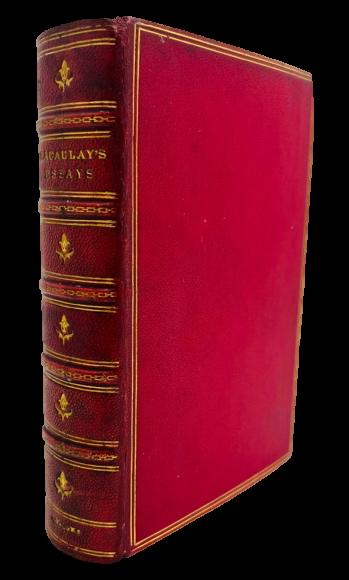
Coke, the founder of his family's fortune. He bought Neales manor in 1609, though never lived there, and made many other purchases of land in
Small 8vo, 350pp Bound in full red hard grain morocco, beveled boards with solid blind tooling to covers and spine, gilt title direct to spine. Non pirelle marble ends. Gilt edges with fore-edge painting.
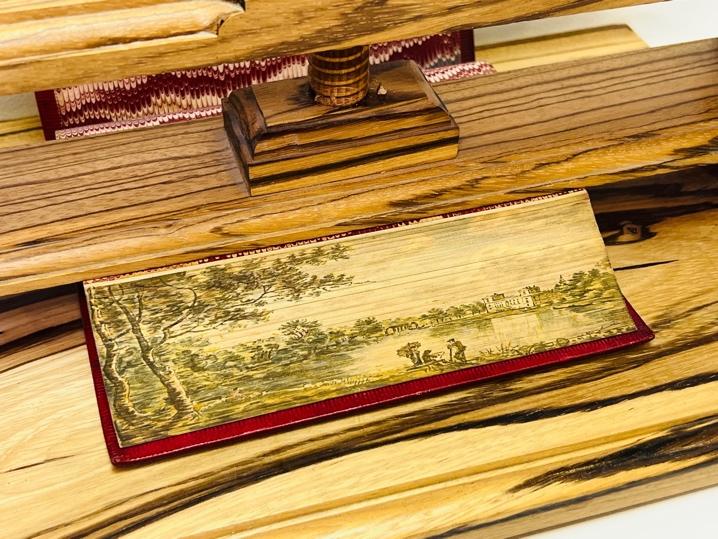
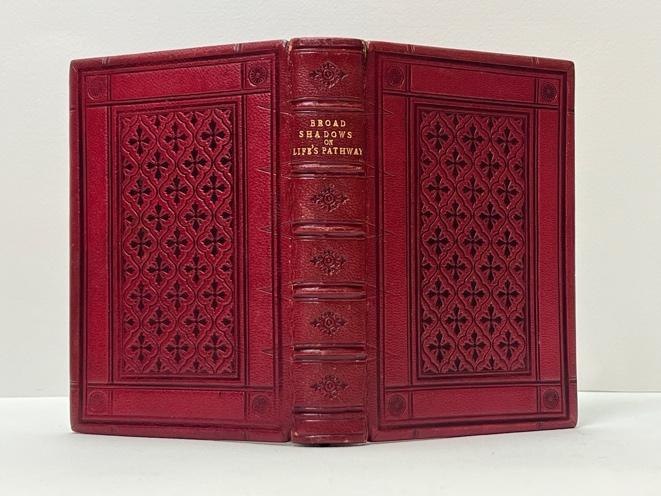
Wilton House from the South East after Richard Wilson. Wilton House is an English country house at Wilton near Salisbury in Wiltshire, which has been the country seat of the Earls of Pembroke for over 400 years. It was built on the site of the medieval Wilton Abbey. Following the dissolution of the monasteries, Henry VIII presented Wilton Abbey and its attached estates to William Herbert, 1st Earl of Pembroke. The present Grade I listed house is the result of rebuilding after a 1647 fire, although a small section of the house built for William Herbert survives; alterations were made in the early 19th and early 20th centuries.
Richard Wilson RA (1 August 1714 – 15 May 1782) was an influential Welsh landscape painter, who worked in Britain and Italy. With George Lambert he is recognised as a pioneer in British art of landscape for its own sake and was described in the Welsh Academy Encyclopedia of Wales as the "most distinguished painter Wales has ever produced and the first to appreciate the aesthetic possibilities of his country". In December 1768 Wilson became one of the founder-members of the Royal Academy. A catalogue raisonné of the artist's work compiled by Paul Spencer-Longhurst is published by the Paul Mellon Centre for Studies in British Art.
From the Preface
The following pages have been written with a two-fold motive. The Author was, in the first place, desirous of tracing the difference between the light which visits the soul in direct rays from the Sun of Righteousness, and that which, however bright and attractive, is only reflected from the outward gifts of God's love, and which is, therefore, liable to be quenched when they are withdrawn.
Price (USD) $620.00 | (GBP) 491.00
Item xx [FORE-EDGE PAINITNG]
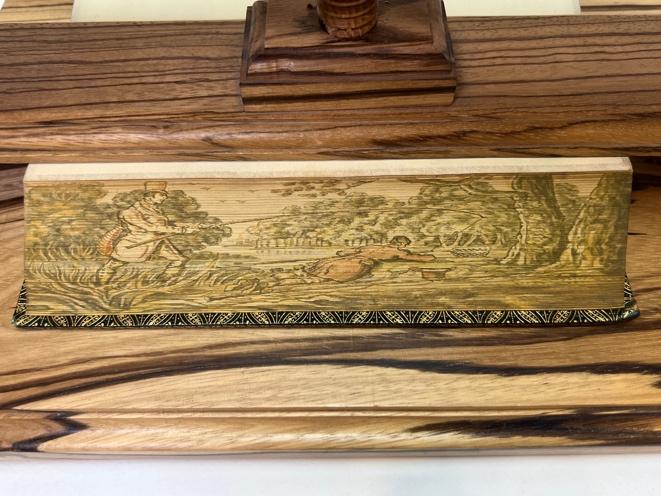
THE LAY OF THE LAST MINSTREL
Walter Scott
Published by Adam and Charles Black, Edinburgh, 1854
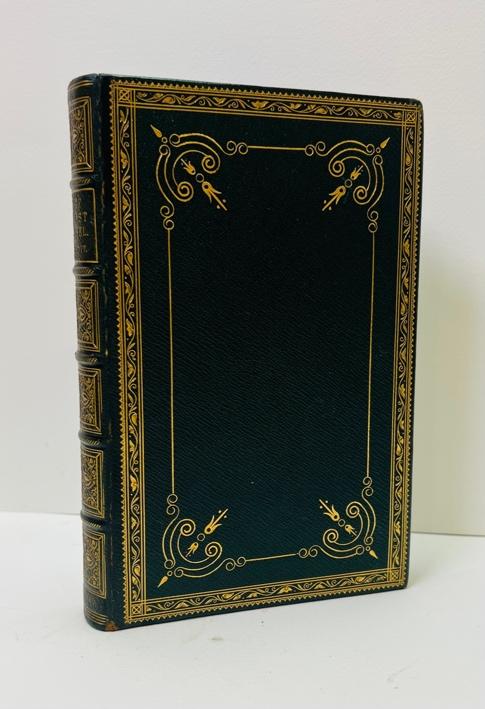
Sir Walter Scott's famous poem The Lay of The Last Minstrel. A long narrative and historical poem, The Lay of The Last Minstrel was originally published in 1805 and follows an ageing minstrel who seeks hospitality at Newark Castle. In recompense for shelter he tells a tale of a sixteenth century Border feud. Illustrated throughout, with numerous engravings from drawings by John Gilbert and Birket Foster. In a signed morocco binding by T Hatchard London. Bound in full paste grain morocco, extra gilt, very fine condition.
FORE
Pike Fishing whimsical scene of two men Pike Fishing English country side.
Price (USD) $680.00 | (GBP) 538.00
Item xxi. [FORE-EDGE PAINITNG]
THE POETICAL WORKS OF SIR WALTER SCOTT

Baronet.
The Globe Edition, with a Biographical and Critical Memoir by Francis Turner Palgrave SCOTT, [Sir] Walter (1771-1832), [PALGRAVE, Francis Turner, editor]
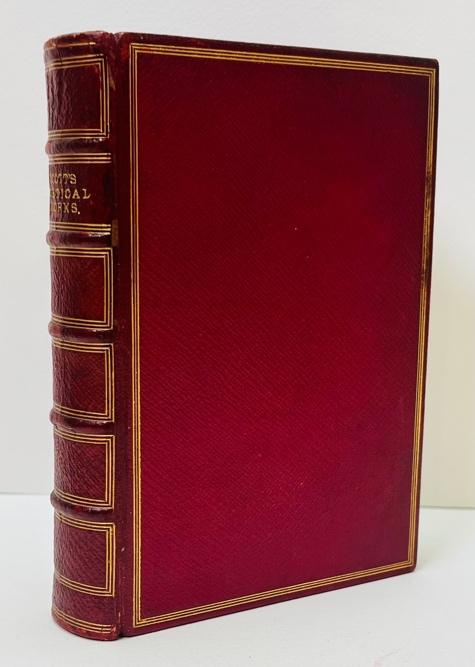
Published by London: Macmillan and Co., 1876,
second fastest rising river in Scotland, and it runs through the village of Ettrick bridge some dozen miles downstream, and the old town of Selkirk. James Hogg (1770 – 21 November 1835) was a Scottish poet, novelist and essayist who wrote in both Scots and English. As a young man he worked as a shepherd and farmhand, and was largely self-educated through reading. He was a friend of many of the great writers of his day, including Sir Walter Scott, of whom he later wrote an unauthorised biography. He became widely known as the "Ettrick Shepherd", a nickname under which some of his works were published, and the character name he was given in the widely read series Noctes Ambrosianae, published in Blackwood's Magazine. He is best known today for his novel The Private Memoirs and Confessions of a Justified Sinner. His other works include the long poem The Queen's Wake (1813), his collection of songs Jacobite Relics (1819), and his two novels The Three Perils of Man (1822), and The Three Perils of Woman (1823).
Price (USD) $810.00 | (GBP) 641.00
Item xxii [FORE-EDGE PAINITNG]
POEMS BY SAMUEL ROGERS
Samuel Rogers
The Globe Edition. Octavo (18 x 13cm), pp. xliv; 559, Small print, mainly in two columns. Bound in full red paste grain morocco gilt boarders and lettering.
FORE-EDGE PAINTING
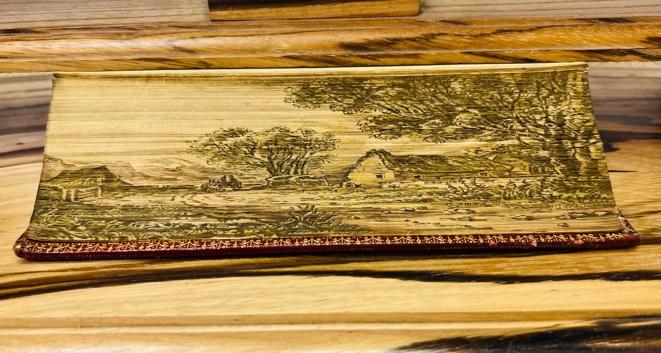
Published by Edward Moxon, London, 1849
Mont Blanc At Day Break
Ettrick, the birth place of James Hogg a rustic poet much helped by Scott.
Ettrick Water is the river which flows through the Ettrick Valley, and across its flood plain, the Ettrick Marshes, within Selkirkshire. It is the
Samuel Rogers' poetry. Full blue paste grain Morocco binding. 318pp, Engraved frontispiece
of Rogers and numerous woodcut vignettes. Containing numerous poems by Rogers, including his well-known 'The Pleasures of Memory'. Other poems include 'An Epistle to a Friend', 'A Wish', 'From a Greek Epigram', 'The Sailor' and 'To the Gnat'. Rogers was greatly celebrated for his poetry during his lifetime, but his success has been eclipsed by other noted Romantic colleagues and friends such as Wordsworth, Coleridge and Byron. Very good condition, with tipped in signature of Samuel Rogers.
FORE-EDGE PAINTING

Mont Blanc at Day Break
Boston: Little, Brown, 1854. 12mo. Bound in red hard grain morocco Blind tooling to covers and spine gilt title, viii, xlii, 280 pp. In 2 volumes Frontispiece engraved portrait with facsimile signature. Very good condition.

Item xxiv. [FORE-EDGE PAINITNG]
Mont Blanc (French: Mont Blanc [mɔ blɑ]; Italian: Monte Bianco [ˈmonte ˈbjaŋko], both meaning "white mountain") is the highest mountain in the Alps and Western Europe, rising 4,807.81 m (15,774 ft) above sea level, located on the FrenchItalian border. It is the second-most prominent mountain in Europe, after Mount Elbrus, and it is the eleventh most prominent mountain summit in the world.
Price (USD) $680.00 | (GBP) 538.00
Item xxiii [FORE-EDGE PAINITNG]
THE POETICAL WORKS OF MATTHEW PRIOR
with a life by Rev. John Mitford
Prior, Matthew;
Published by Little, Brown, Boston, 1860
VOL 1. BRIDGES CREEK
WESTMORELAND COUNTY VA. WASHINGTON’S BIRTHPLACE
At the age of 24, George Washington’s greatgrandfather John Washington immigrated to Virginia from England and settled on Mattox Creek land given to him by his father-in-law. He purchased 100 acres of land on the east side of Bridge’s Creek in 1664, near the confluence of Potomac River, now part of the George Washington Birthplace National Monument The monument spans 551 acres of the former Popes Creek Plantation, the American ancestral home of the Washington Family where George Washington was born.



